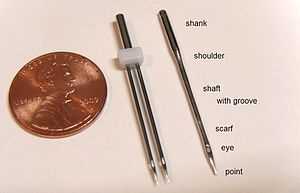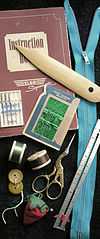Sewing machine needle

A sewing machine needle consists of:[1]
- shank - clamped by the sewing machine's needle holder
- shoulder - where the thick shank tapers down to the shaft
- shaft - a length suitable for driving the eye and thread through the material and down to the bobbin
- groove - cut in the back of the shaft to release the thread into a loop that aids the hook or shuttle to pick up the thread
- scarf - provides extra room for the hook or shuttle to pass close by
- eye - carries the thread
- point - penetrates the material by parting the threads or cutting a hole
Choosing the right needle
Needles fall into three primary categories [2]-- ball point, sharp, and rounded-sharp. It is important to use the correct needle.
Ball point needles are designed to alleviate making holes in knit or loosely woven materials. The cross fibers which constitute the knit or loosely woven materials are relatively far apart as compared to those in tightly woven materials. If a knit strand of thread is cut with a sharp needle, it produces a hole that will enlarge when the loose fibers pull back from the cut. To prevent this, the ball point needle is designed to push aside the individual strands of the knit. This assumes that the ball point needle point is in good condition. If you notice rough edges on your embroidery or other developing irregularities, it is time to change to a new needle.
Sharp needles are designed for woven fabrics. Because of the tightness of the weave, individual cut fibers will not pull away and make holes. For this exact reason it is important not to use ball point needles on wovens. The blunt force of a ball point will tear through the fibers and actually pull them in the process, resulting in uneven, irregular embroidery and damage to the fabric. Sharp needles can be used on all wovens as well as dense materials such as leather, vinyl, canvas, etc.
Point types

Sewing machine needles each have one of three different point types:
- regular point, the finest point, for parting the threads of woven fabrics
- ball point, for knit fabrics; its round point minimizes cut threads by allowing them to move out of the way
- chisel point, for leather, capable of punching its own holes as it goes
Singer color codes
Singer colors its needles with a system of color codes which indicate the needle's type:
| Shank color | Point type |
|---|---|
| red | regular, for woven |
| yellow | ball, for knits |
| blue | heavy-duty, for denim |
| brown | chisel, for leather |
| Shoulder color | Shaft size |
|---|---|
| green | 9 (thinnest) |
| orange | 11 |
| blue | 14 |
| purple | 16 (thickest) |
Kenmore color codes
Kenmore colors its needles with a different system of color codes which indicate the needle's size:
| Shank color | Shaft size | Shaft size (Europe) |
|---|---|---|
| blue | 11 | 75 |
| orange | 12 | 80 |
| red | 14 | 90 |
| purple | 16 | 100 |
| green | 18 | 110 |
Schmetz Color Codes
The colored band on some types of Schmetz needles indicates the needle type. [3]
| Shank color | Type |
|---|---|
| yellow | Stretch |
| blue | Jeans |
| green | Quilting |
| red | Embroidery |
| purple | Microtex (sharp) |
References
- ↑ Lydia Morgan (November 6, 2008). "Machine-needle know-how". Threads Magazine (94): 59–61.
- ↑ Bob Purcell. "Using the Right Needle". Retrieved January 30, 2012.
- ↑ Schmetz Needle Chart
| ||||||||||||||||||||||||||||||||||||||
